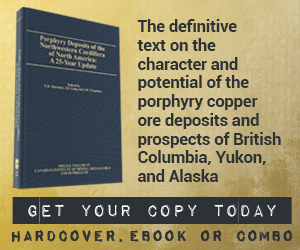Library Magazine Articles Implementation of 2014 CIM Definition Standards
Implementation of 2014 CIM Definition Standards
Paul Bankes - Aug 2015
Part two of two
The CIM Standing Committee on Mineral Reserve and Mineral Resource Definitions maintains the CIM definitions that are incorporated by reference into National Instrument 43-101 Standards of Disclosure for Mineral Projects (NI 43-101) and represents CIM on the Committee for Mineral Reserve International Reporting Standards (CRIRSCO).
In 2014 the Committee completed a three-year update of the definitions and guidance that form the CIM Definition Standards for Mineral Resources and Mineral Reserves. NI 43-101 references these standards for mineral reserve and mineral resource definitions, definition guidance and clas---sification scheme. The revised CIM Definition Standards harmonized definitions with CRIRSCO partners and addressed changes in NI 43-101 as well as requests for clarification and guidance from industry and Canadian Securities Administrator (CSA) staff. Following extensive consultation with industry, CIM members and CSA, the results were incorporated in the final Definitions Standards and approved by CIM Council on May 10, 2014.
The alignment of the 2014 Definition Standards with NI 43-101 for the permitted disclosure of Mineral Resource estimates and Preliminary Economic Assessments (PEAs) is an important aspect of the recent update.
Upon its inception in 2001, NI 43-101 allowed a Preliminary Assessment (PA) to include Inferred Mineral Resources. On June 30, 2011, CSA changed the name of a PA to PEA, and allowed Inferred Mineral Resources to be included in a mine plan, production schedule and financial analysis. However, CSA maintained the prohibition against disclosing the results of a prefeasibility study, feasibility study or life of mine plan at a developed mine that included Inferred Mineral Resources in the mine plan, production schedule and financial analysis. While the CSA’s decision did not materially impact the previous CIM definition, it did contradict the 2005 and 2010 CIM definition guidance that minimized the confidence associated with an Inferred Mineral Resource and discouraged the use of Inferred Mineral Resources to “evaluate economic validity worthy of public disclosure.”
To address this inconsistency, the above guidance was removed from the 2014 Definition Standard and the following phrase was inserted into the Inferred Mineral Resource definition to recognise the heightened importance and use of Inferred Mineral Resources in the preparation of a PEA:
“It is reasonably expected that the majority of Inferred Mineral Resources could be upgraded to Indicated Mineral Resources with continued exploration.”
For international practitioners reporting under multiple CRIRSCO codes and standards, the revised text has been included in the CRIRSCO International Reporting Template and seven of eight member codes. The South African reporting code is expected to incorporate CRIRSCO core definitions in 2016.
In recognition of CSA’s continued prohibition against disclosing the results of a prefeasibility study, feasibility study, or life of mine plan at a developed mine that includes Inferred Mineral Resources in the mine plan, production schedule and financial analysis, the definition guidance for an Inferred Mineral Resource was modified to include the following guidance:
“Inferred Mineral Resources can only be used in economic studies as provided under NI 43-101.”
NI 43-101 only allows Inferred Mineral Resources to be included in a PEA that is independent of both prefeasibility and feasibility studies.
Finally, further guidance was needed to clarify a Qualified Person’s obligation to clearly state the basis for determining that a Mineral Resource has reasonable “prospects for eventual economic extraction.” To address this concern, the following guidance was added to the Mineral Resource Definition:
“The Qualified Person should consider and clearly state the basis for determining that the material has reasonable prospects for eventual economic extraction. Assumptions should include estimates of cutoff grade and geological continuity at the selected cutoff, metallurgical recovery, smelter payments, commodity price or product value, mining and processing method and mining, processing and general and administrative costs. The Qualified Person should state if the assessment is based on any direct evidence and testing.”
At its core, the committee considers the determination of “reasonable prospects for eventual economic extraction” to be a judgment by the Qualified Person after evaluating the technical and economic factors likely to influence the prospect of economic extraction. Portions of a deposit that do not have potential for eventual economic extraction cannot be included in a Mineral Resource statement.
Although many practitioners believe a Mineral Resource should be reported within a pit shell, or preliminary underground mining outline, the committee strongly believes flexibility is required to allow a Qualified Person to demonstrate mineability without the aid of advanced optimization software. In many cases, mineability and strip ratio can be demonstrated on a series of plans and sections. While this is particularly true for early-stage projects based on Inferred Mineral Resources, the Qualified Person is obligated to clearly state the basis for the determination of “reasonable prospects for eventual economic extraction.” This disclosure should state whether the assessment relies on any direct evidence and testing and should not be limited to the disclosure of assumptions listed in the guidance.
In conclusion, the alignment of the 2014 Definition Standards with NI 43-101 for the permitted disclosure of Mineral Resource estimates and PEAs, as well as new guidance to clarify the Qualified Person’s obligation to clearly state the basis for determining “reasonable prospects for eventual economic extraction” represented a significant improvement to the CIM Definition Standards.
Author
Paul Bankes is a geologist with more than 30 years of domestic and international experience in project development, mine operations, geostatistics, mine design and business development. Paul chairs the CIM Standing Committee on Mineral Reserve and Mineral Resource Definitions and represents CIM on CRIRSCO and the UN Experts Committee on Resource Classification.

.png)
